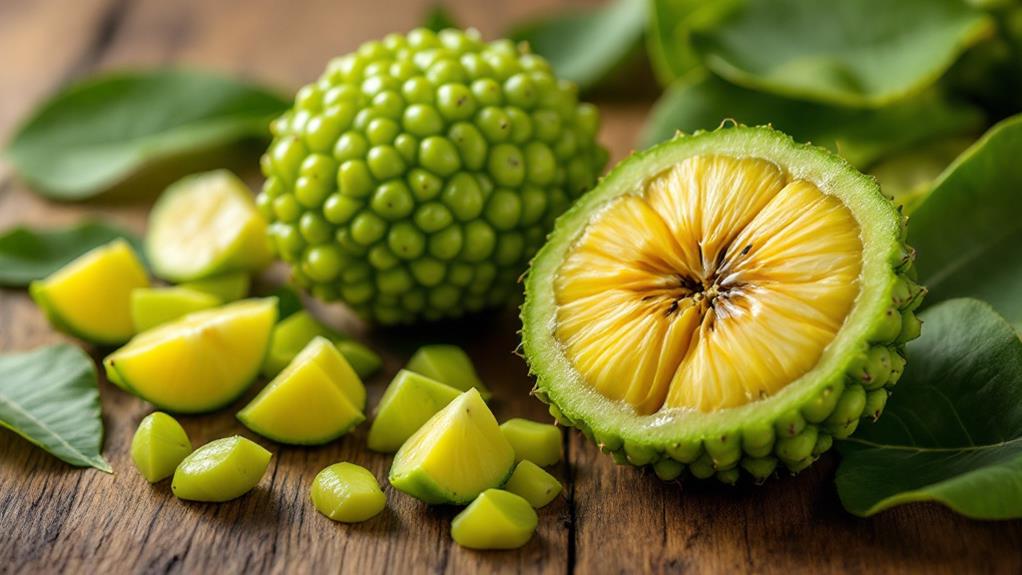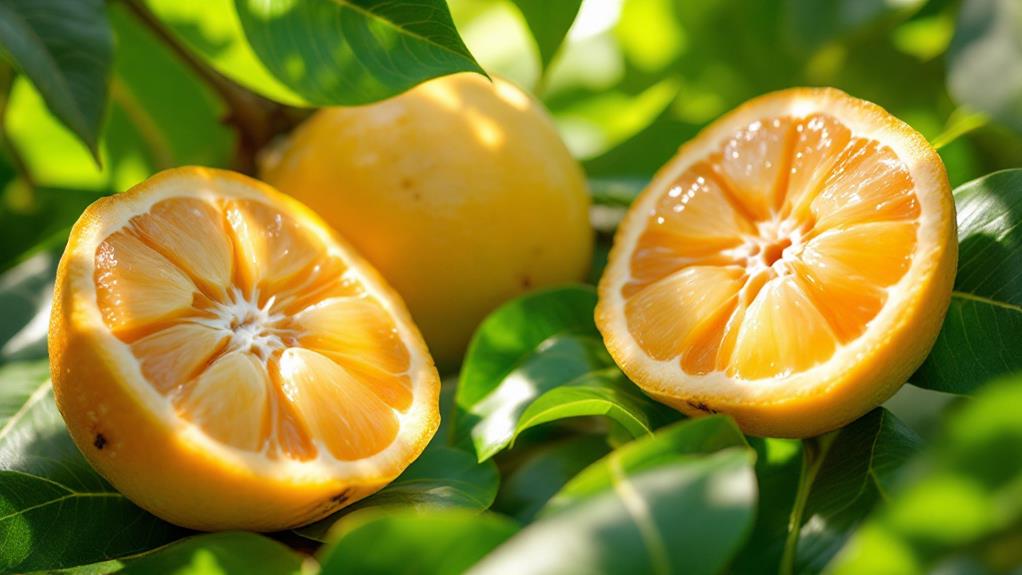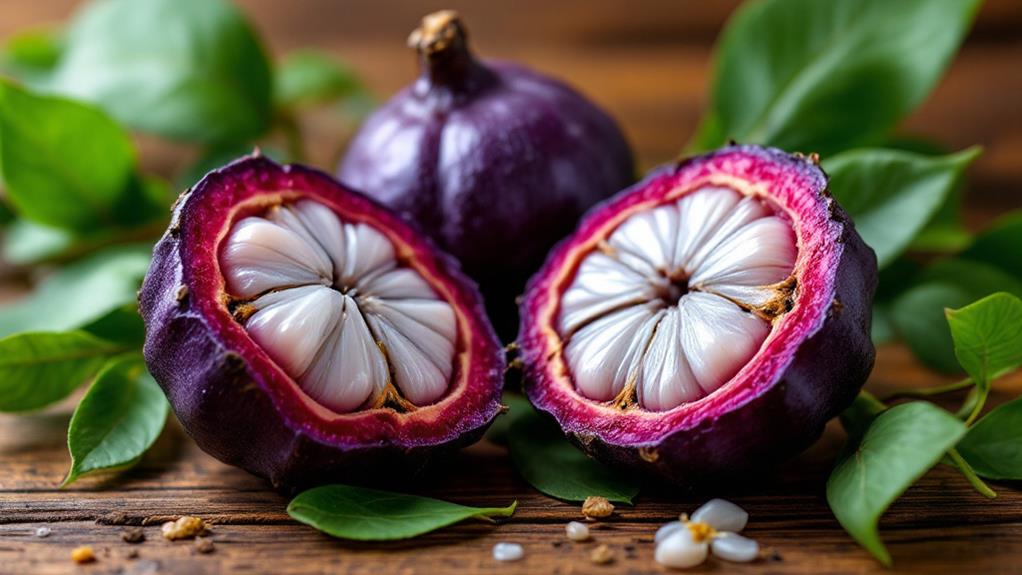Dragon Fruit: A Tropical Source of Fiber and Antioxidants
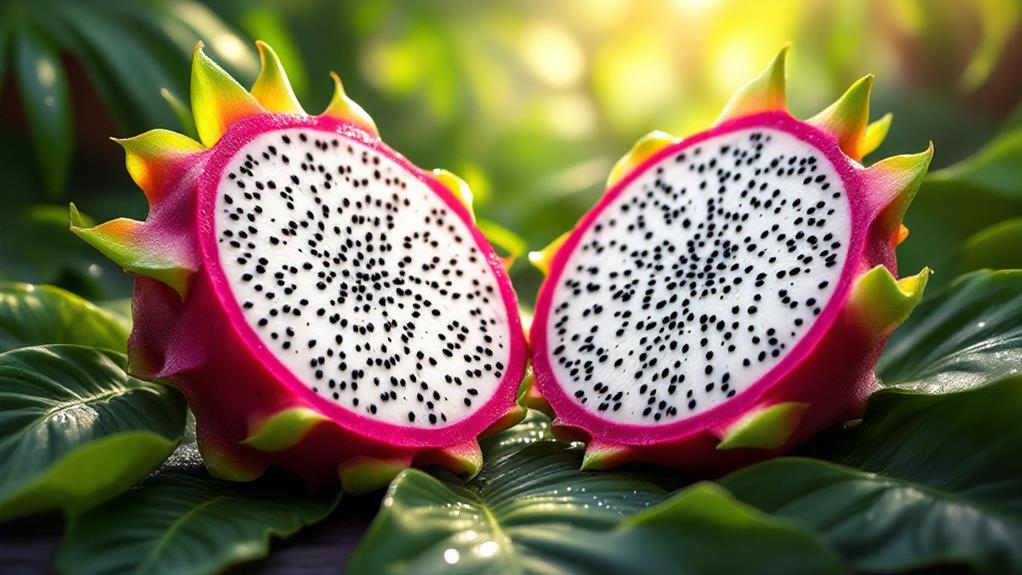
Dragon fruit, also known as pitaya, is a lively tropical treat that's both nutritious and delicious. You'll find it loaded with fiber, making it fantastic for digestion and promoting a feeling of fullness. Its rich antioxidants like betalains and flavonoids help reduce the risk of chronic diseases while supporting skin health. With just about 60 calories per 100 grams, it's a great option for weight management. Enjoy dragon fruit raw or in smoothies and salads for a invigorating burst of flavor. Immerse yourself in the different varieties and you'll appreciate their unique colors and health benefits even more.
What Is Dragon Fruit
Dragon fruit, often called pitaya, is a lively and exotic fruit that comes from the Hylocereus cactus. This tropical fruit is native to southern Mexico and Central America, and it's now grown in tropical and subtropical regions worldwide. When you initially encounter dragon fruit, its vivid skin catches your eye with hues of hot pink or yellow, adorned with green, spike-like leaves. This unique appearance isn't just for show; it hints at the fruit's rich nutritional benefits.
Packed with fiber and antioxidants, dragon fruit is a powerhouse for health benefits. You'll find that its antioxidants help combat oxidative stress, while the fiber supports a healthy digestive system. These elements make it a popular choice among health enthusiasts looking to enhance their diet with natural goodness.
The fruit's varieties offer different experiences, with some having white flesh and others red, each with a sweet flavor reminiscent of kiwi and pear. Despite its exotic look, dragon fruit is easy to incorporate into your diet, adding both taste and nutrition. Whether you're seeking vivid skin or a nutritious snack, dragon fruit is a delicious, health-enhancing option.
Varieties of Dragon Fruit
When exploring the varieties of dragon fruit, you'll encounter a diverse range of flavors and shades. Each variety of dragon fruit offers unique flavor profiles and distinct appearances. The white dragon fruit, known scientifically as Hylocereus undatus, features pink skin and white pulp, delivering a milder taste with less sweetness. If you're seeking a sweeter option, the red dragon fruit varieties, such as Red Jaina and Bloody Mary, boast lively red or pink pulp. These varieties are not only richer in flavor but also packed with antioxidants, enhancing their health benefits.
The yellow dragon fruit, or Hylocereus megalanthus, stands out with its smooth, thin skin and incredibly sweet white pulp. Though harder to find, it's prized for its luscious taste. Primarily grown in Ecuador, this variety is a treat for those who prefer sweetness. Meanwhile, the American Beauty variety presents a pink exterior and striking purple flesh. Introduced to the U.S. from Guatemala, it offers a unique flavor and appearance that captivates both the eye and palate.
Each variety of dragon fruit brings its own charm and health benefits, making them a delightful and nutritious supplement to your diet.
Nutritional Composition
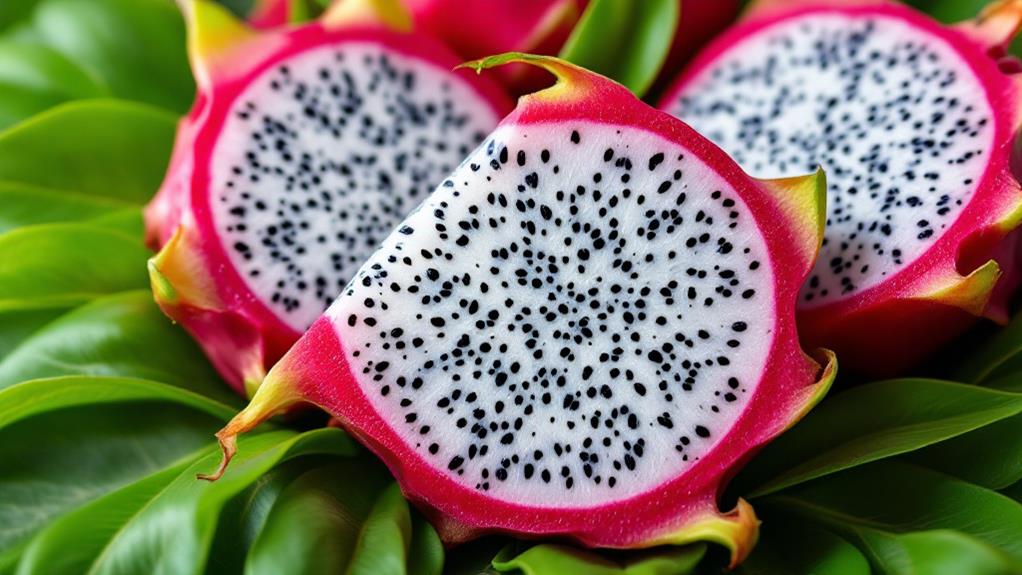
In exploring the nutritional profile of dragon fruit, you'll find it to be a low-calorie delight, with only about 57-60 calories per 100 grams. This tropical fruit is a smart choice if you're watching your calorie intake. Dragon fruit packs a punch with its nutritional composition, offering a mix of carbohydrates and a notable dose of fiber—about 3 grams per 100 grams. This fiber content not only supports digestive health but also helps you feel fuller longer.
You'll be pleased to know that dragon fruit is virtually fat-free, containing a mere 0.14 grams of fat per 100 grams. It also provides a small amount of protein, around 0.36 grams, making it a light yet nutritious snack. The fruit is rich in vital vitamins, particularly Vitamin C, offering 5% of your daily value in just a one-cup serving. Furthermore, dragon fruit is a good source of magnesium, providing 2% of the daily value, and includes iron, though in smaller amounts at 1% DV.
Lastly, don't forget the antioxidants present in dragon fruit, which play a significant role in maintaining general health. Enjoy this lively fruit, knowing it's as nutritious as it is delicious.
Health Advantages
Building on its impressive nutritional profile, you'll find that dragon fruit offers several compelling health advantages. Initially, it's low in calories, with just 57-60 calories per 100 grams, making it a smart choice for those watching their weight. Despite its sweet flavor, dragon fruit won't derail your diet. Rich in dietary fiber, it provides about 7 grams per cup, which aids digestion and helps you feel full longer, supporting effective weight management.
Dragon fruit's high antioxidant content, including betalains and flavonoids, plays an essential role in protecting your body from oxidative stress. These antioxidants are key in reducing the risk of chronic diseases like heart disease and cancer, offering a significant health benefit. Additionally, dragon fruit is a good source of vitamin C, which supports your immune system and skin health, delivering around 5% of your Daily Value per serving.
While dragon fruit is known for its prebiotic fibers, which improve gut health, it also strengthens your body's defenses against illness. By incorporating dragon fruit into your diet, you can enjoy its delightful taste while reaping a myriad of health benefits, from enhanced immune function to reduced disease risk.
Role in Gut Health
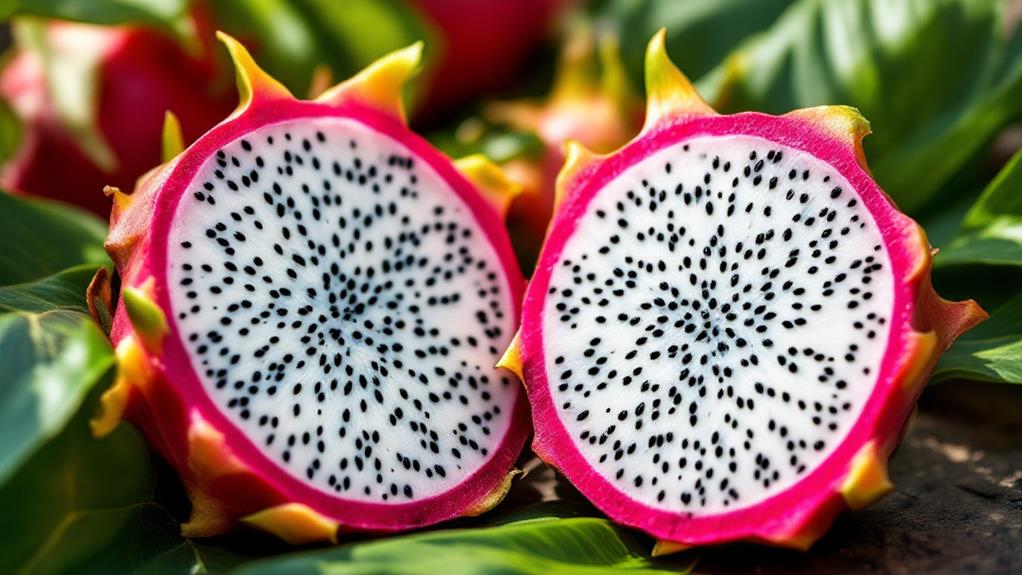
Dragon fruit really steps up regarding gut health. It's packed with dietary fiber, offering about 7 grams per one-cup serving. This fiber is vital for digestive health, keeping your bowel movements regular and your gastrointestinal health in check. By eating dragon fruit, you're not just getting fiber; you're also ingesting prebiotic fibers. These fibers promote the growth of beneficial bacteria in your gut, which can reduce the risk of infections and improve your comprehensive gut health.
Moreover, the antioxidants found in dragon fruit, like betalains and flavonoids, play a significant role in combating oxidative stress in your gut. This protection helps maintain the integrity and function of your digestive system. Regular consumption of dragon fruit can even support weight management, which is essential for a balanced gut microbiome.
Including dragon fruit in your diet can lower the risk of developing common digestive conditions such as constipation and diverticulosis. So, by embracing this tropical fruit, you're not only delighting your taste buds but also nurturing your gut health with fiber, antioxidants, and prebiotic benefits, ensuring a happier, healthier digestive system.
Culinary Applications
Some might say that dragon fruit is as adaptable as it is colorful. You'll find that its culinary applications are assorted, making it a delightful enhancement to different dishes. When added to fruit salads, dragon fruit not only improves the flavor with its unique taste but also raises the visual appeal, creating a lively and antioxidant-rich dish.
Blending dragon fruit into smoothies is a fantastic way to enjoy its benefits. Pair it with tropical fruits like pineapple and mango for a revitalizing drink that's both tasty and nutritious. If you're into desserts, consider making sorbet or ice cream. Dragon fruit's lively color and unique taste will surely uplift your frozen treats to a whole new level.
For savory options, you can grill dragon fruit to add a sweet contrast to meats and salads. This unexpected twist introduces a new layer of flavor and antioxidants to your meals, surprising your taste buds. Ultimately, don't underestimate its striking appearance as a garnish. Regardless of whether it's on a salad, yogurt, or dessert, dragon fruit can improve any dish with its bold look and delightful taste.
Preparation Methods
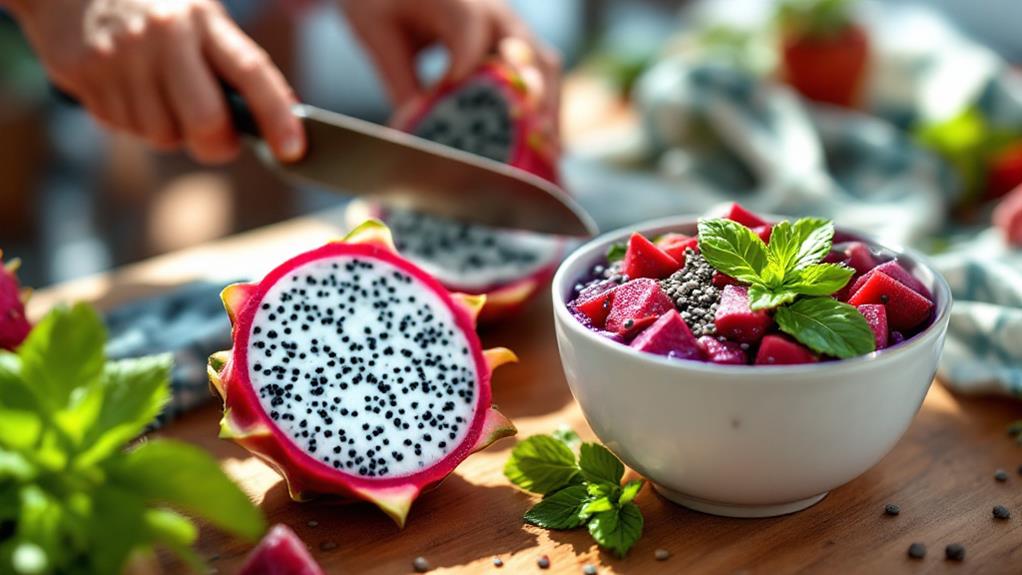
When preparing dragon fruit, you'll want to start by selecting one with bright red skin that gives slightly when pressed, signaling ripeness. Avoid any overly mushy fruits. Once you've got a ripe fruit, the initial step is to cut it in half lengthwise. You can then scoop out the flesh with a spoon if you prefer a quick and simple method. Alternatively, make vertical and horizontal cuts to create easy-to-serve cubes.
Dragon fruit can be consumed raw, offering a delightful and subtle sweetness. It's versatile and can be incorporated into a variety of dishes. Add it to salads for a pop of color and texture, blend it into smoothies for a nutritional enhancement, or use it in desserts for an exotic twist. For those who enjoy beverages, dragon fruit can be blended with other fruits like kiwi and pineapple, creating invigorating juices and cocktails.
While the peel is edible, it has a bitter taste. If you choose to eat it, verify it's thoroughly washed to remove any pesticides. These preparation methods will help you enjoy dragon fruit's unique flavors and health benefits.
Potential Side Effects
While enjoying the exotic taste and nutritional benefits of dragon fruit, it's vital to be aware of its potential side effects. Although generally safe, some individuals might experience allergic reactions, such as swelling or hives. If you notice these symptoms after consuming dragon fruit, it's imperative to seek medical advice.
The high fiber content, while advantageous for digestion, can lead to digestive upset if you're not used to it. Symptoms like bloating or diarrhea might occur, so it's best to enjoy dragon fruit in moderation. Gradually introducing it into your diet can help minimize these effects.
Here are significant considerations for consuming dragon fruit:
- Moderation: Overconsumption can lead to gastrointestinal discomfort due to its high fiber content.
- Thorough Washing: The peel is edible and full of antioxidants, but it may contain pesticides. Always wash it thoroughly to guarantee safety.
- Red Urine: Don't be alarmed if you notice pink or red urine after eating red dragon fruit; it's harmless and results from betalains.
Understanding these potential side effects guarantees a safe and enjoyable experience with dragon fruit, optimizing its benefits while minimizing any discomfort.
Purchasing Tips
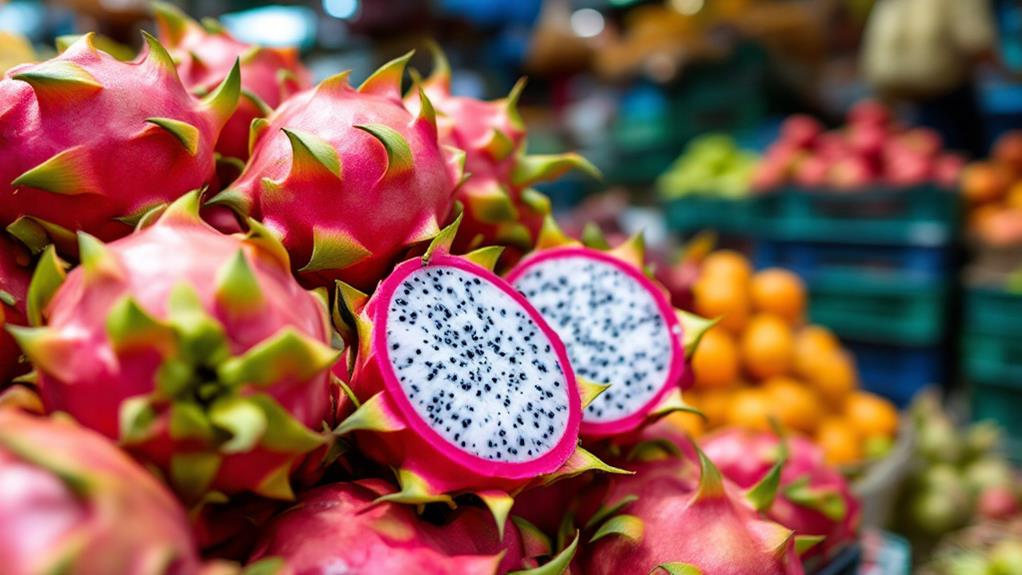
Dragon fruit's appeal is not just in its taste but also in its colorful appearance, making it crucial to know how to choose the best ones. When you're selecting dragon fruit, look for bright skin that signals ripeness and freshness. Avoid any with excessive bruising or blemishes. A quick squeeze should reveal a texture akin to ripe avocados or kiwis—slightly squeezable but not mushy. This is a good indicator of prime ripeness.
Consider the variety as well. White dragon fruit is less sweet, while red dragon fruit and its yellow counterpart offer a more flavorful experience. Knowing your preference will guide your selection. Don't forget to check for seasonal availability. Dragon fruit is typically in season from summer to early fall, so it's more accessible and potentially fresher during these months.
For the best quality, purchase dragon fruit from specialty grocery stores or markets that focus on tropical fruits. These places are more likely to prioritize freshness and quality. By following these purchasing tips, you'll be able to enjoy the lively taste and benefits of dragon fruit at its best.

